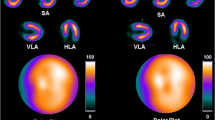Abstract
Background
Previously we reported that compared to iterative reconstruction with ordered subset expectation maximum (OSEM), wide beam reconstruction (WBR), which incorporates resolution recovery and controls noise during reconstruction without applying a post-processing filter, allows half-time SPECT acquisition with preserved diagnostic quality. We now postulate that with further Poisson noise treatment, quarter-time acquisition is possible.
Methods
The half-time WBR algorithm was optimized for quarter-time acquisition based upon anthropomorphic cardiac phantom data and a pilot group of 48 patients (pts). Then using the modified algorithm, 209 pts (91 men, 118 women, mean chest circumference = 40 in) were imaged at rest (R) and stress (S) (9/32 mCi 99mTc-sestamibi) full-time with OSEM, and again quarter-time with the modified WBR algorithm. The 180°, 64-stop, full-time single-day rest (R) (25 second-per-stop, sps) and 8-frame per cardiac cycle post-stress (S) (20 sps) gated SPECT, and then quarter-time R (6 sps) and post-S (4 sps) gated SPECT were acquired. Blinded observers graded scan quality (1 = poor to 5 = excellent) based on myocardial uniformity, endocardial/epicardial edge definition, and background noise. Perfusion defects were scored using a 17-segment model. Using three commercially available software methods, end-diastolic volume (EDV), end-systolic volume (ESV), and left ventricular ejection fraction (LVEF) were calculated.
Results
For the 209 prospective pts, mean image quality for R full-time OSEM and quarter-time WBR were similar (3.5 ± 0.9 vs 3.6 ± 0.7, p NS). For S, quarter-time WBR quality was superior to full-time OSEM (4.3 ± 0.7 vs 3.9 ± 0.7) (P = 1.78 × 10−17). In 35 pts with chest circumferences >44 inches a longer, 10 sps WBR acquisition improved resting image quality. Of 48 pts with abnormal scans (SSSs > 2 by OSEM) mean summed stress scores, summed rest scores, and summed difference scores were not significantly different with quarter-time WBR vs full-time OSEM (11.2 vs 10.9), (9.1 vs 9.0), (2.0 vs 1.9) (P NS). For the three software methods, there was a good correlation of LVEF, EDV, and ESV determined by WBR vs OSEM (all r > 0.92). ESVs were generally higher with WBR, primarily due to better delineation of the valve plane at end-systole, whereas EDVs were similar. Thus, EFs were significantly lower with WBR.
Conclusions
For perfusion SPECT quarter-time WBR affords image quality, defect characterization, and functional assessment equivalent to full-time OSEM.














Similar content being viewed by others
References
Sharir T, Ben-Haim S, Merzon K, Prochorov V, Dickman D, Ben-Haim S, et al. High-speed myocardial perfusion imaging: Initial clinical comparison with conventional dual detector anger camera imaging. J Am Coll Cardiol Img 2008;1:156-63.
Patton JA, Smolka PJ, Germano G, Berman DS. Recent technologic advances in nuclear cardiology (image reconstruction advances). J Nucl Cardiol 2007;14:505-6.
Maddahi J, Mendez R, Babla H, Bai Chuanyong B, Arram S, Conwell R. Prospective multicenter clinical evaluation of rapid SPECT myocardial perfusion upright imaging. J Nucl Cardiol (this issue)
Venero CV, Ahlberg AW, Bateman TW, Katten D, Courter SA, McGhie AI, et al. Enhancement of nuclear cardiology laboratory efficiency: Multicenter evaluation of a new postprocessing method with depth-dependent collimator resolution applied to full and half-time acquisitions. J Am Coll Cardiol 2008;51(Suppl A):170.
Cullom SJ, Saha K, Heller GV, Bateman TM. An optimized iterative reconstruction and processing protocol for “half-time” (32 projections) REST/STRESS Tc99m-sestamibi myocardial perfusion SPECT. J Nucl Cardiol 2008;15(4):S6.
Borges-Neto S, Pagnanelli RA, Shaw LK, Honeycutt E, Shwartz SC, Adams GL, et al. Clinical results of a novel wide beam reconstruction method for shortening scan time of cardiac SPECT perfusion studies. J Nucl Cardiol 2007;14:555-65.
DePuey G, Gadiraju R, Cark J, Thompson L, Anstett F, Shwartz SC. Ordered subset expectation maximization and wide beam reconstruction “half-time” gated myocardial perfusion SPECT functional imaging: A comparison to “full-time” filtered back projection. J Nucl Cardiol 2008;15:547-63.
DePuey G, Gadiraju R, Anstett F. OSEM and WBR half-time gated myocardial perfusion SPECT: A comparison to filtered backprojection. J Nucl Med 2007;48:237P.
Cantinho G, Pena H, Veiga A, Marques AV, Fonseca E, Shwartz SC, et al. WBR versus FBP in myocardial perfusion SPECT reconstruction-diagnosis impact. J Nucl Cardiol 2007;14:S108.
Basso D, Passmore G, Holman M, Rogers W, Walters L. A clinical evaluation of a wide beam reconstruction method for shortening scan time of gated cardiac rest/stress SPECT. J Nucl Med 2006;47:534P.
Pena H, Cantinho G, Shwartz SC, Pinhero M, Goncalves P, Godinho F. Has wide beam reconstruction technology for myocardial perfusion SPECT any impact on functional cardiac parameters? Eur J Nucl Med Mol Imaging 2006;33(Suppl 2):207-27 (abstract).
Cantinho G, Pena H, Shwartz SC, Montiero J, Pereira L, Cerquiera D, et al. Wide beam reconstruction technology: Does it respect myocardial perfusion SPECT functional parameters? J Nucl Cardiol 2007;14(Suppl 1):S56 (abstract).
DePuey G, Bommireddipalli S, Beletsky I, Clark J, Leykekhman A, Thompson L, et al. Quarter-time myocardial perfusion SPECT wide beam reconstruction. J Am Coll Cardiol 2008;51(Suppl A):172.
DePuey G, Bommireddipalli S, Belesky I, Clark J, Leykekhman A, Thompson L, et al. Quarter-time myocardial perfusion SPECT wide beam reconstruction. J Nucl Cardiol 2008;15:S2.
UltraSPECT R&D team, Haifa, Israel. Wide beam reconstruction: Technology and applications (white paper) 2008. www.ultraspect.com.
Bateman TM, Heller GV, McGhie AI, Courter SA, Golub RJ, Case JA, et al. Multicenter investigation comparing a highly efficient half-time stress-only attenuation correction approach against standard rest-stress Tc-99m SPECT imaging. J Nucl Cardiol 2008;15:S3.
Bateman TM, Heller GV, McGhie AI, Courter SA, Kennedy KF, Katten D, et al. Application of simultaneous Gd-153 line source attenuation correction to half-time stress only SPECT acquisitions: A multicenter clinical evaluation. J Am Coll Cardiol 2008;51:A171.
Acknowledgment
Grant support: UltraSPECT, Ltd., Haifa, Israel.
Author information
Authors and Affiliations
Corresponding author
Rights and permissions
About this article
Cite this article
DePuey, E.G., Bommireddipalli, S., Clark, J. et al. Wide beam reconstruction “quarter-time” gated myocardial perfusion SPECT functional imaging: a comparison to “full-time” ordered subset expectation maximum. J. Nucl. Cardiol. 16, 736–752 (2009). https://doi.org/10.1007/s12350-009-9108-7
Received:
Revised:
Accepted:
Published:
Issue Date:
DOI: https://doi.org/10.1007/s12350-009-9108-7




